- As the city of Palu mourns the dead from an earthquake
and tsunami, it is haunted by questions of whether the
government could have stemmed the devastation.
Hannah Beech
Muktita Suhartono

Most of Petobo, a middle class neighborhood in the eastern Indonesian city of Palu, vanished into the vortex of mud created by the earthquake on Sept. 28. One of the greatest horrors born that day was that it was little surprise.
The city straddles the Palu Koro fault, in one of the most tectonically violent zones on Earth. And despite earthquake after earthquake here over the years — and an explicit warning two years ago from scientists that Palu faced deadly consequences if precautions were not taken — the 7.5 magnitude quake last month caught officials unprepared for a fully predicted disaster.
“We failed the people of Palu,” said Rusdy Mastura, the city’s former mayor.
In the aftermath, with thousands of bodies still thought to be submerged in the buried debris, there is growing evidence that this was a crisis that was both natural and man-made.
In a front-line earthquake zone, much of Palu had sprung up in the form of unreinforced buildings on soft ground. A tsunami was quickly detected, but no siren rang around the city. And despite hard lessons from previous natural disasters in which Indonesian authorities discouraged outside help at the expense of its citizens, the international aid effort in Palu was still dogged by resistance and confusion.
The most prominent active fault on the Indonesian island of Sulawesi, Palu Koro is akin to a “fault superhighway,” according to Ian M. Watkinson, a seismologist who has studied the area, which is part of an earthquake-plagued arc along the Pacific Ocean called the Ring of Fire.
In a paper published in 2016, Mr. Watkinson and colleague Robert Hall of Royal Holloway University of London warned that what makes the city of Palu so ideal for human habitation — fertile land on a horseshoe bay, backed by verdant mountains — is also what makes it so dangerous.
The geological phenomenon that swallowed 744 houses in Petobo and most of two other neighborhoods last month is called liquefaction, when the shuddering of an earthquake transforms solid earth into a gelatinous gush.
Mr. Watkinson and Mr. Hall wrote in their paper that Palu was particularly at risk to strong earthquakes, to the liquefaction of its soft and saturated soil, and to a tsunami barreling down its narrow bay.
All three calamities struck on Sept. 28.
“It’s not that we wanted to be right,” Mr. Watkinson said. “It’s that the geological evidence pointed very strongly to the likelihood of something like this occurring.”
In 2012, the Geological Agency at Indonesia’s Ministry of Energy and Mineral Resources produced a map of Palu that documented areas where liquefaction was likely to occur. Many of the city’s large residential zones — like Petobo and Balaroa, another neighborhood inundated on Sept. 28 — were included in the highest-risk red zone.
“We delivered the geological map to the Central Sulawesi government,” said Sri Hidayati, who runs the earthquake mitigation division at the geological agency. “But probably they didn’t know the meaning of the map. We never received any feedback.”
As Indonesia’s economy developed, Palu’s population surged, prompting new developments on swampy, sandy soil. Nearby deforestation and gold mining shifted sediment in the region, making the ground less stable underfoot.
Petobo and Balaroa, another Palu neighborhood inundated by liquefaction, used to be mainly sago fields, flat expanses with ample water access. When the government began building subsidized housing for new residents, many civil servants, in the 1980s and 1990s, this converted farmland seemed a natural fit.
“We never knew about liquefaction,” said Suhardy, a building contractor who lives near Balaroa. “What we only knew was that Palu is earthquake prone.”
The dangers of the earth are hard-wired in Indonesians. On Thursday, a 6.0 magnitude earthquake struck offshore near the Indonesian islands of Bali and Java, and at least three people were reported killed. On Saturday, a 5.6 magnitude quake hit northern Sulawesi.
“The whole of Indonesia is at high risk of earthquakes,” said Rahmat Triyono, the earthquake and tsunami chief at the Meteorology, Climatology and Geophysics Agency. With four tectonic plates jostling under the Indonesian archipelago, the country is now cleaved by 295 active faults, up from 81 in 2010.
Yet in the rush to accommodate a rapidly urbanizing Indonesia, new buildings were thrown up, often made of poor quality cement, Mr. Wilkinson of Royal Holloway University said.
“There’s a transition time when the growth of a country exceeds the ability for building engineers to design for peak survivability,” he said. “If you compare to Tokyo or Santiago, which have strictly enforced building codes and earthquake-resistant buildings, none of that is possible in a city like Palu.”
Sukmandaru Prihatmoko, the chairman of the Indonesian Association of Geologists, said that although Indonesian building codes look adequate on paper, “enforcement has been weak, very weak.”
Building the foundations of houses beyond the sandy layer that is prone to liquefaction could have prevented loss of life in Palu, Mr. Sukmandaru said.
“Then again, if you are building a housing complex, you don’t really want to add that extra cost of an extra deep foundation,” he added.
In the days following Palu’s tragedy, with 70,000 people displaced and aftershocks still unnerving survivors, the city’s leadership seemed to have disappeared.
Neither the mayor of Palu, Hidayat, nor the vice mayor, Sigit Purnomo Syamsuddin Said, responded to repeated calls and text messages from The New York Times.
“Where are the civil servants? Where was the governor’s office? Where was the mayor’s office?” Vice President Jusuf Kalla of Indonesia asked last week in Jakarta, the nation’s capital. “The government was not present when they were needed.”
Instead, the military tried to instill order. But in the chaotic days after the quake, soldiers could be seen helping themselves to some of the supplies trucked in by aid groups or standing by as residents swarmed the vehicles. With little information flowing in from local officials, military personnel dispatched to Palu struggled to calculate the body count, stumbling over basic addition.
In one case, updates to the daily death toll were foiled when it was discovered that the previous day’s numbers had been written on a whiteboard in permanent marker.
And although foreign aid was eventually allowed in, unlike during the earthquake on the island of Lombok in August, the national disaster mitigation agency took to Twitter last week to warn that “foreign citizens who are working with foreign NGOs are not allowed to conduct any activity on the sites affected,” ordering international groups to “retrieve their personnel immediately.”
The day after, the Foreign Ministry issued a statement clarifying that the directive was not meant as a blanket renunciation of foreign aid but rather a plea for better integration with local agencies.
“All assistance including foreign volunteers should only enter after coordination and approval has been given, so their purpose, role and function are clear,” the statement said.
But foreign aid workers continue to complain of delays in getting supplies approved for import and of being hassled on the ground by officials.
For its part, the national geophysics agency, which has been criticized for having allowed part of its tsunami warning system to go dormant, is struggling with chronic budget shortfalls. Of the 170 tidal gauges that Indonesia has to monitor changes in water levels, there is only enough money to maintain 70 of them, said Mr. Rahmat, the agency’s earthquake and tsunami chief.
“We are an earthquake- and tsunami-prone country,” he said. “The risks are very clear, but the budget allocated does not match the risks.”
Chains of command are frayed. On Sept. 28, a tsunami warning was issued by the agency a couple minutes after the quake. A siren had been placed near Palu’s stadium for just that purpose. But it never sounded. Mr. Rahmat said that he was still unsure why.
“We also have to check if the system is 24 hours,” he said. “Maybe when the warning went out, the office had closed. We don’t know.”
Or perhaps it was human error by a government worker that resulted in merrymakers at a beach festival in Palu being swept out to sea, never aware that a tsunami was rolling in.
“Even though the operator’s job is to turn on the siren, it’s human to panic, then run,” Mr. Rahmat said.
In Gorontalo Province, on the same island of Sulawesi as Palu and marred by another major active fault, Sultan Kalupe, the head of the spatial planning division of the provincial ministry of public works, said he was surprised to hear from a Times reporter that a government map had been issued in 2012 cautioning that his region was at a high risk of liquefaction.
The Gorontalo map was issued by the Geological Agency the same year Palu’s hazards were published.
“We never knew such a study existed,” Mr. Sultan said. “If there is such a study, that would be great because we are revising our city plan.”
In the wake of the Palu earthquake, he said, city officials were intent on moving residents away from the most liquefaction-prone areas. Where the money will come for this project is not clear. “When you know you have the potential for disaster but you didn’t make any plan,” Mr. Sultan said, “that’s catastrophic.”



